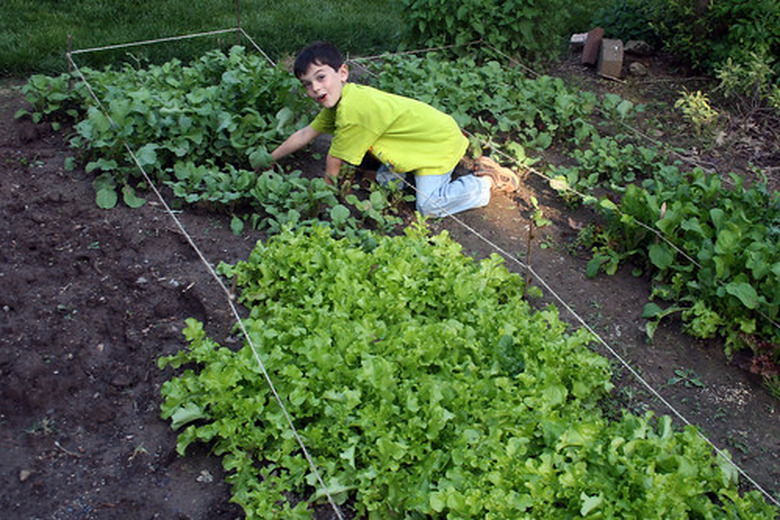Fall Vegetable Garden In Georgia
Georgia is a fairly temperate state, with most of its area being in USDA hardiness zones 7a to 8b. That means that in addition to a spring garden, you also can plant vegetables in late summer or early fall for a second crop. Not all vegetables will do well; many young seedlings can't handle the humid summer heat. But there are lots of vegetables that will thrive and give you produce to tide you over until the following spring. While there are hundreds of cultivars worth trying, the ones listed below are recommended by the University of Georgia College of Agricultural and Environmental Sciences Department.
Beans
Four kinds of beans can be planted in Georgia in the fall: bush, pole, lima and pole lima.
Bush beans should be planted from July 5 through August 10. They take 50 to 60 days to mature. According to UGA, the best cultivars for the area include Bronco, Kentucky Runner and Roma.
- Georgia is a fairly temperate state, with most of its area being in USDA hardiness zones 7a to 8b.
- Not all vegetables will do well; many young seedlings can't handle the humid summer heat.
Pole beans, lima beans and pole lima beans all can be planted between July 1 and Aug. 1. Pole and lima beans take 65 to 75 days to mature; pole lima beans take 80 to 85 days. Pole bean cultivars include Dade, Moccasin and Kentucky Blue. Lima bean cultivars include Jackson Wonder and Henderson's Bush. Pole lima beans cultivars include Florida Speckled and Sieva.
Asparagus
Asparagus should be planted in November and December. The best cultivars for the area, according to UGA, include Jersey Knight, Jersey Giant, Purple Passion and Mary Washington. Asparagus does not mature for picking until its second year.
- Pole beans, lima beans and pole lima beans all can be planted between July 1 and Aug. 1.
- The best cultivars for the area, according to UGA, include Jersey Knight, Jersey Giant, Purple Passion and Mary Washington.
Beets
Beets should be planted between Aug. 1 and Sept. 20. They take 55 to 65 days to mature, depending on the cultivar. Cultivars include Red Ace, Ruby Queen and Detroit Dark.
"Cole" Crops
Cole crops are plants belonging to the Cruciferae or mustard family. They include cabbage, broccoli, collards, kale, mustard and cauliflower.
Plant cabbage between Aug. 1 and Oct. 1. Cabbage takes 70 to 120 days to mature. Cultivars include Bravo, Rio Verde and Blue Dynasty.
- Beets should be planted between Aug. 1 and Sept. 20.
- They take 55 to 65 days to mature, depending on the cultivar.
Broccoli should be planted between Aug. 1 and Sept. 1. It takes 60 to 80 days to mature. Cultivars include Marathon, Patriot and Packman.
Plant collards between Aug. 1 and Sept. 1. Collard greens take 55 to 85 days to mature. Cultivars include Hevi-Crop and Blue Max.
Kale should be planted between Aug. 1 and Sept. 1. It takes 50 to 70 days to mature. Cultivars include Vates, Blue Armor and Blue Knight.
- Broccoli should be planted between Aug. 1 and Sept. 1.
- Cultivars include Vates, Blue Armor and Blue Knight.
Plant mustard between Aug. 15 and Sept. 15. Mustard takes 40 to 50 days to mature. Cultivars include Red Giant, Savannah and Florida Broadleaf.
Plant cauliflower between July 15 and Aug. 15. It takes 60 to 75 days to mature. Cultivars include Early Snowball, White Magic and Absolute.
Cucumber
Cucumber , whether pickling, slicing or gynoecious (mostly female flowers), should be planted between July 15 and Aug. 15. It takes 50 to 65 days to mature. Slicing cultivars include Bush Crop, Diva, Fanfare and Sweet Success. Pickling cultivars include Country Fair and Calypso. Gynoecious cultivars include General Lee and Calypso.
- Plant mustard between Aug. 15 and Sept. 15.
- Gynoecious cultivars include General Lee and Calypso.
Lettuce
Lettuce should be planted between Sept. 1 and Oct. 1. It takes 60 to 85 days to mature. Cultivars include Romaine, Buttercrunch and Butterhead.
